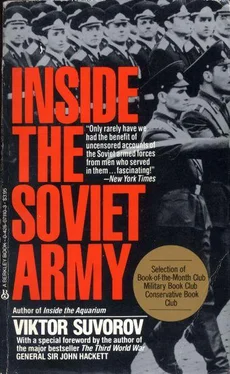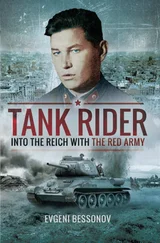This policy of secrecy is applied to the production of heavy assault guns, mounted on tank chassis. A tank with a fixed turret is an excellent weapon. True, its arc of fire is reduced, but against this, a more powerful gun can be installed, the quantity of ammunition it carries can be increased, its armour can be strengthened without increasing its overall weight and, most important, it is much easier to manufacture. Guns of this sort are indispensable, when used in close conjunction with tanks with normal turrets. Both the Soviet and the German generals came to realise their value during the war, but since then only the former have continued to produce them. In order that other countries should not be tempted to introduce this simple but excellent weapon, all Soviet heavy assault guns are protected by strict security measures. Their production has continued, without a break, ever since the war. Every motor-rifle regiment (inside the USSR, but not abroad) has one battery of heavy assault guns. In the 1950s the powerful D-74 (122mm) was mounted on a T-54 tank chassis, then the M-46 gun (1 30mm) was installed on the T-62 tank chassis. All regiments, without exception, have heavy assault guns of this type. They are kept in mothballs for decades, never seeing the light of day. Their crews train on T-54 and T-62 tanks. Sometimes they are shown the gunsights of the assault guns. They know the tactics which will be used and they know how to service the engines. If war should break out their commander would disclose to them that instead of tanks they were about to be equipped with something which was similar but far more powerful and better armoured. In the middle of the 1970s all these guns were replaced by more powerful models but, naturally, they were not melted down. Instead they were either sent to the Chinese frontier to be installed in concrete emplacements or sent to holding depots, in case they should come in useful one day.
The same secrecy is maintained around the IT-1 and IT-2 anti-tank rocket launchers and the Rapira-2 and Rapira-3 anti-tank guns.
The IT-1 is built on a T-62 tank chassis but is armed with the `Drakon' anti-tank rocket instead of a gun. Each Army has one battalion of IT-1s, which are kept in mothballs, well concealed and never seen even by the battalion's own soldiers. If the Army to which it belongs is posted abroad, the battalion remains on Soviet territory, to all appearances an ordinary tank battalion. Its soldiers are given instruction in tactics and driving and maintenance of the vehicles but ordinary tanks or training simulators are used for this.
In this way it is possible to serve out your time in the Soviet Army, learning nothing-or very little-about its equipment.
How Much Does All This Cost?
1
Nothing at all. I will repeat that. All this costs nothing at all.
Let us imagine that you work at a full-time job, but that your wife does not. You give her an allowance and she has no other source of income. You start to give her driving lessons and decide to make yourself some money by doing so. After all, you are using up energy, time, labour, nerves and petrol. But now answer a question-is it more in your interest to make your wife pay through the nose for her lessons, or to keep the price low? Which will be more profitable for you?
If you were giving lessons to a neighbour, of course, you would ask as high a price as you felt you could. But what should you do when you are teaching your own wife? The more money you make her pay, in the hope of becoming rich, the more she will need from you, for where else could she get it?
If you lower your fee, you will need to give your wife less, and she will let you have less back. You soon realise that whatever you charge she will just be taking money from your pocket and then returning it to you.
Now, turn your thoughts to the 6th Guards Tank Army, with its thousands of tanks and tens of thousands of men. Imagine yourself to be the Communist Pharaoh, the General Secretary of the Communist Party of the Soviet Union. Something strange-goodness knows what-is going on in Czechoslovakia. To safeguard yourself you decide to move the 6th Guards Army up to your frontier with this fraternal state. It is only possible to move a thousand tanks over a distance of a thousand kilometres by rail, for tanks wear out roads very fast-and vice versa. How much is this going to cost you? You summon the Minister of Railways (being nationalised, the railways are fully controlled by the people-in other words by the government-that is, by you personally) and put this question to him. He tells you-`100 million rubles'. This means that you will have to take 100 million rubles out of the State's pocket and give it to the Army; the Army pays the money to the railways, which, in turn, puts this, the profit they have made, back into the State's pocket. What on earth is the point of taking it out in the first place, if it was going to be put back almost immediately? So, in fact, it does not get taken out in the first place. The General Secretary just summons the Minister and tells him to move the 6th Guards Tank Army. The Minister says `Yes, Sir', clicks his heels and does as he has been told. That is all. No money is needed for the operation. The same system applies to any movement by individual soldiers. An officer comes to a railway station and shows papers which say that in the national interest he is to proceed to the Far East. What would be the point in giving the officer money, for him to pay a State organisation, which must then refund the same money to the State?
In the Soviet Union everything has been nationalised. Private deals are forbidden. Since everything is in the hands of the State, prices for goods produced for the State have no meaning. Tanks, guns, rockets-none has any price inside the State. It is like growing a strawberry in your garden, selling it to yourself and eating it, moving the money you pay for it from your right pocket to your left one. Your strawberry only acquires a price if you sell it to someone else and put the money he pays you into your pocket. In the same way, Soviet tanks acquire a price only when someone abroad buys them.
For the State, which owns all the safes in the land, to move billions of rubles from one safe to another is meaningless. So nothing is moved. A Ministry simply receives an order to produce a thousand tanks or rockets or bombers and to deliver them to the armed forces. That is all. If a minister does not carry out his orders he loses his place at the ministerial feeding-trough. Money of a sort is paid to the workers but it is really nothing but the equivalent of ration cards. Workers are given just enough to buy bread or potatoes, a poor quality suit every three years and vodka every day. This money is printed by the State but it is not recognised by anyone abroad, since it can not be exchanged for gold.
In the Soviet Union there are virtually no taxes, because they are not needed. Everything is in the hands of the State, everything has been nationalised. A Soviet banknote is essentially a ration card, issued by the State for work done in its interests. Why hand out ten ration cards and then take five of them back again? The State does not grow any richer by re-acquiring these cards, which do not help to make more meat available in the shops. Accordingly, the State, which prints these cards, produces only enough to buy the amount of bread, potatoes, rotten meat and old fashioned clothes which it is prepared to distribute to its citizens. The latter eat the meat and give the ration cards back to the State, which hands them out again.
Sometimes the State becomes more concerned about producing tanks than food, but it must continue to hand out ration cards to the people. This creates inflation, since now the ration cards can not even purchase bread and this soon has a calamitous effect on the whole huge military machine.
Читать дальше












